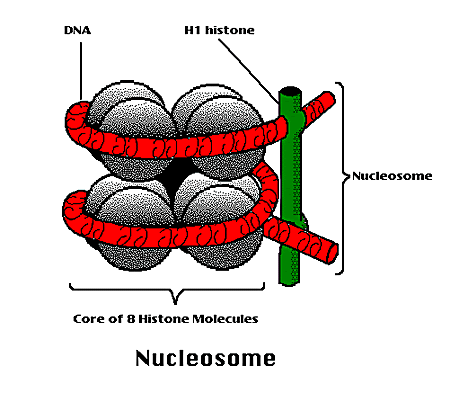DNA packaging in cell [with exercise questions]

Cells have DNA, the blueprint of life. DNA consists of two chains of sugar, phosphate and four different bases. As the genetic information is incorporated in the arrangement of these bases, bases are combined firmly to mutually act as a template in order to maintain the arrangement. When DNA is irradiated, it may be partially damaged depending on the amount of radiation.
DNA is small but very long
The haploid human genome contains approximately 3 billion base pairs of DNA packaged into 23 chromosomes. Most cells in the body are diploid, with 23 pairs of chromosomes. That makes a total of 6 billion base pairs of DNA per cell. Because each base pair is around 0.34 nanometers long, each diploid cell contains about 2 meters of DNA. Moreover, the human body contains about 30 trillion cells—which works out to 60 trillion meters of DNA per human. Now, consider the fact that the Sun is 150 billion meters from Earth. This means that each of us has enough DNA to go from here to the Sun and back more than 200 times, or around Earth’s equator 1.5 million times! What a tremendous project to packaging those DNA into 23 small chromosomes!
DNA, Histones, and Chromatin
We have to give credit to certain proteins for compact chromosomal DNA into the microscopic space of the eukaryotic nucleus. These proteins are called histones, and the resulting DNA-protein complex is called chromatin. Within the nucleus, histones provide the energy to fold DNA.
Histones are a family of small, positively charged proteins termed H1, H2A, H2B, H3, and H4. DNA is negatively charged, due to the phosphate groups in its phosphate-sugar backbone, so histones bind with DNA very tightly. As a result, chromatin can be packaged into a much smaller volume than DNA alone.

Because DNA wraps around histones, histones also play a important role in chromatin regulation and in the regulation of gene expression. A histone modification is a covalent post-translational modification (PTM) to histone proteins, which can impact gene expression by altering chromatin structure or recruiting histone modifiers. Histone modifications act in diverse biological processes such as transcriptional activation/inactivation, chromosome packaging, and DNA damage/repair.
The Unit of Chromatin:Nucleosome
The basic repeating structural unit of chromatin is the nucleosome, which contains eight histone proteins and about 146 base pairs of DNA. Today, researchers know that nucleosomes are structured as follows: Two each of the histones H2A, H2B, H3, and H4 come together to form a histone octamer, which binds and wraps approximately 1.7 turns of DNA, or about 146 base pairs. The addition of one H1 protein wraps another 20 base pairs, resulting in two full turns around the octamer, and forming a structure called a chromatosome. Every chromosome contains hundreds of thousands of nucleosomes, and these nucleosomes are joined by the DNA that runs between them.

This page has been viewed times.